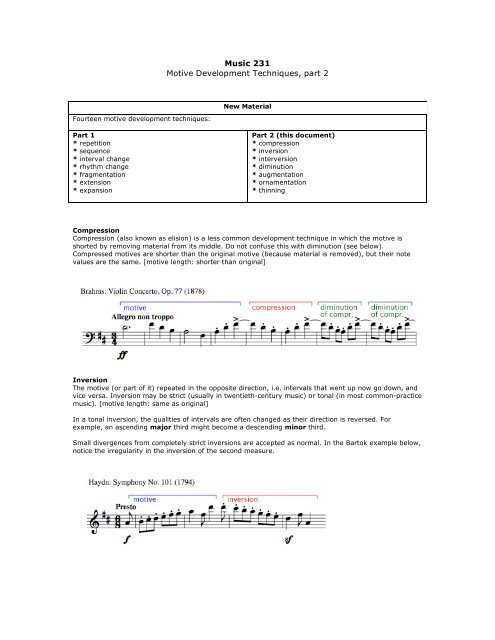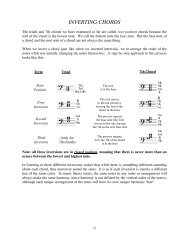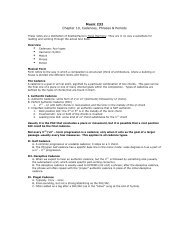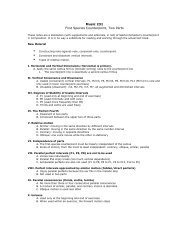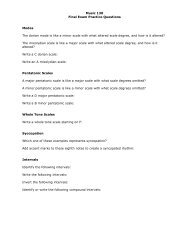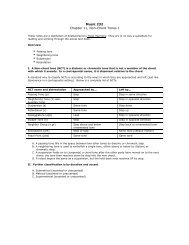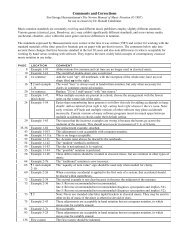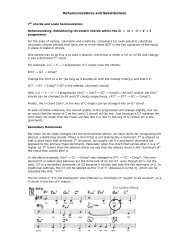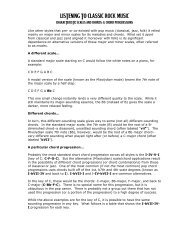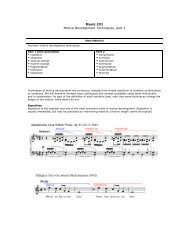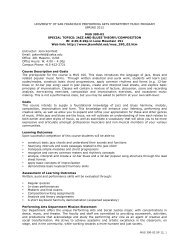Music 231 Motive Development Techniques, part 2 - Jkornfeld.net
Music 231 Motive Development Techniques, part 2 - Jkornfeld.net
Music 231 Motive Development Techniques, part 2 - Jkornfeld.net
Create successful ePaper yourself
Turn your PDF publications into a flip-book with our unique Google optimized e-Paper software.
<strong>Music</strong> <strong>231</strong><strong>Motive</strong> <strong>Development</strong> <strong>Techniques</strong>, <strong>part</strong> 2Fourteen motive development techniques:New MaterialPart 1* repetition* sequence* interval change* rhythm change* fragmentation* extension* expansionPart 2 (this document)* compression* inversion* interversion* diminution* augmentation* ornamentation* thinningCompressionCompression (also known as elision) is a less common development technique in which the motive isshorted by removing material from its middle. Do not confuse this with diminution (see below).Compressed motives are shorter than the original motive (because material is removed), but their notevalues are the same. [motive length: shorter than original]InversionThe motive (or <strong>part</strong> of it) repeated in the opposite direction, i.e. intervals that went up now go down, andvice versa. Inversion may be strict (usually in twentieth-century music) or tonal (in most common-practicemusic). [motive length: same as original]In a tonal inversion, the qualities of intervals are often changed as their direction is reversed. Forexample, an ascending major third might become a descending minor third.Small divergences from completely strict inversions are accepted as normal. In the Bartok example below,notice the irregularity in the inversion of the second measure.
InterversionInterversion is the restatement of a motive with its germs reordered. [motive length: same as original]In the second example below, notice the introduction of a new germ in conjunction with the interversion.This results in an unusual five-measure phrase.
Diminution and AugmentationIn a motivic restatement, note values may be shortened (diminution) [motive length: shorter thanoriginal] or lengthened (augmentation) [motive length: longer than original] .In early contrapuntal forms (fugues, canons, etc.), these processes were applied strictly to every note of amotive: every note value would either be doubled, quadrupled, halved, or quartered. In the eighteenthand ni<strong>net</strong>eenth centuries, liberties were sometimes taken so that some notes would be shortened (orlengthened) while others would not, or they might be shortened or lengthened by different amounts.
Ornamentation and ThinningOrnamentation is a common technique in which notes are added to the motive while keeping the melodicand rhythmic outline of the motive intact. (Note that these notes are specifically written into the music bythe composer, unlike the implied ornamentation is Baroque music or in improvisational music.) Thinning isthe opposite process, removing some notes but retaining the essential outline. [motive length: same asoriginal]
Additional examplesThe body of music literature contains countless examples of development techniques that are too subtle ortoo individual to catalogue. Further, the techniques listed in these pages are often combined in uniqueways. Examine the examples below, paying special attention to combinations of development techniques.You may need to describe variations as based on multiple techniques (for example a sequence with arhythmic change) or you may wish to describe consecutive techniques (for example the first germ mightbe inverted, the second germ might be sequenced).Bach: The Art of Fugue, Canon I
Dvorak: Symphony No. 9, Fourth MovementSummaryTechnique Method Length of originalrepetition restatement samesequence restatement transposed sameinterval changesame rhythm, interval orsameintervals alteredrhythm change same intervals, rhythm varied samefragmentation<strong>part</strong> of original (usually a germ) shorterrepeatedextension material added at end of motive longerexpansionmaterial added in the middle of longerthe motivecompressionmaterial removed from the shortermiddle of the motiveinversion interval direction reversed sameinterversiongerms presented in a different sameorderdiminution note values reduced shorteraugmentation note values lengthened longerornamentation non-harmonic tones added samethinningnon-harmonic and/orornamenting tones removedsamePlease note: the information on this page has been supplied by Dr. Ronald Caltabiano


